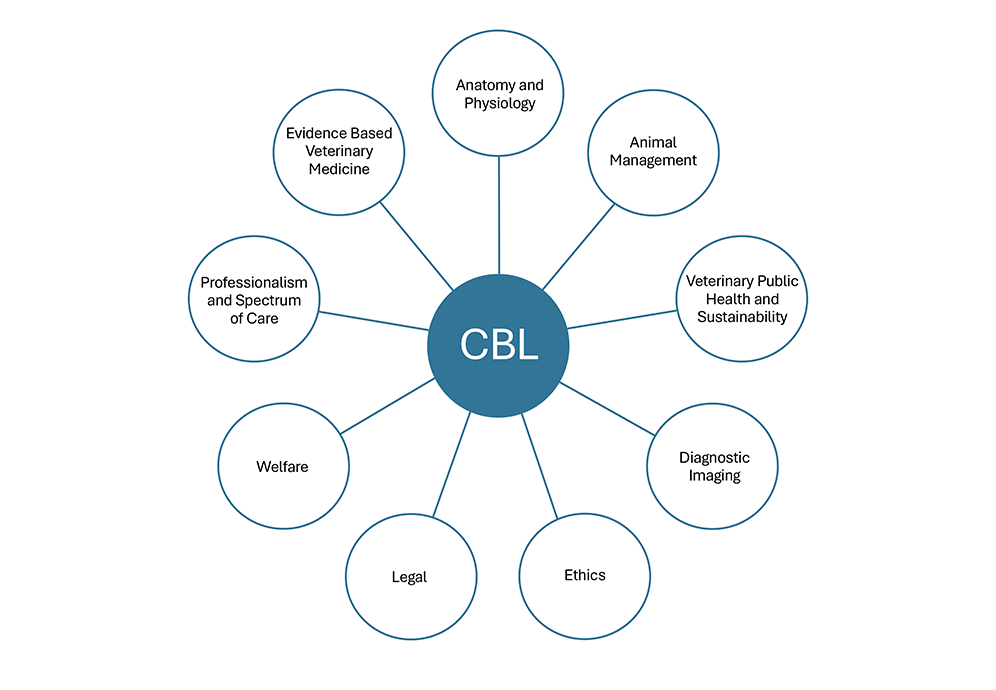Case Based Learning
What is CBL?
Case-based learning (CBL) is any teaching method that uses clinical cases as the basis for learning. There are many teaching methods that come under the umbrella of CBL, but at Bristol Veterinary School two specific types of CBL are used extensively, these are “7-Step CBL” and “Consolidation CBL”. Both of these methods involve students working in small groups using clinical scenarios as the basis for learning the fundamentals of veterinary science (Figure 1: Examples of topics that are taught, in part, through CBL).
Figure 1
In CBL students take an active, rather than a passive, role in the learning process. This means that rather than passively receiving information from a teacher, learners instead actively develop their own knowledge in collaboration with other students and guided by a teacher.
Passive Learning: Listening to a podcast where someone is describing a book and offering their opinions on it.
Active learning: Going to a book club and getting involved with the discussions about a book you have read.
View students and staff discussing CBL at Bristol Veterinary School
How much time is allocated to CBL at Bristol Veterinary School?
Many learning outcomes are delivered solely through CBL. It is estimated that CBL takes up about 50% of the total study time on the programme and includes facilitated and non-facilitated group work, and independent study time.
7-Step CBL
Each group of 10-12 students is presented with a clinical case which is used to explore key topics related to the case that are fundamental to veterinary science. (See example box).
They do this using a standard 7-step framework that is summarised in Figure 2.
Extract from a clinical case: “A 7-year-old male neutered domestic shorthair cat is presented to the veterinary practice for sneezing, inappetence and lethargy. The cat is presented by the owner of the cattery where he is staying whilst his owners are on holiday”
Fundamentals that students may identify are required to understand this case:
- Anatomy and physiology
- Anatomy of the nasopharynx
- Defenses of the respiratory tract against pathogens
- Legal/professionalism
- Do we need the owner’s permission to treat this patient and what is “permission”?
- What laws cover catteries and kennels?
- Behaviour
- Normal cat behaviour
- Indicators of disease
- Diet
- What do cats eat?
- Types of food available for domestic cats
Figure 2

Steps 1-5 are guided by a facilitator who may step in to steer the group back onto course or ask questions to stimulate discussion. The facilitator is not there to directly explain concepts or teach in a traditional, lecture-style way.
At the start, Case Based Learning was new to me and I wasn’t really sure how to navigate it but the more experience I had with Case Based Learning, the more I found it was a really good chance to take what I’d learnt in lectures and discuss it as a group. You get to hear different people’s experiences and opinions and I think you learn a lot more that way, rather than just being sat in a lecture hall.
Case Based Learning has helped prepare me for real-world practice because we discuss a lot of real life cases. The cases are all things we are likely going to see in the future as vets and it’s really helpful discussing that. It has also helped me to prepare to work with people from lots of different backgrounds. I feel more prepared to work with a team in the future, working with lots of people with different personalities.
My favourite thing about Case Based Learning is the collaborative effort. Everyone brings different things to the table. If someone struggles with a case one week, that’s offset by the fact that someone really has a passion for that area which is great. I also love the problem solving aspect. It is like going into a giant puzzle every week and whilst you follow a structure each time it is a different case so that’s really interesting.
Consolidation CBL
Consolidation CBL occurs at the end of each system block and is about bringing together the knowledge gained over the preceding weeks. In contrast to 7-Step CBL, consolidation CBL takes place in a large room that can hold the whole year group. Within this large room students are divided into smaller sub-groups of 6-8 to work on the case. Each group will work through a highly structured clinical case using their new scientific knowledge to complete quizzes and other interactive elements, with experts on hand to answer questions and provide real life knowledge and insight.
How much guidance do students receive?
All CBL is guided and supported by facilitators but the amount of direction that students receive is dependent on the case and the needs of the group.
How is CBL assessed?
CBL learning is assessed by single best answer (also known as Multiple Choice) questions and multiple short answer (also known as short answer) questions in the end of unit examinations.
